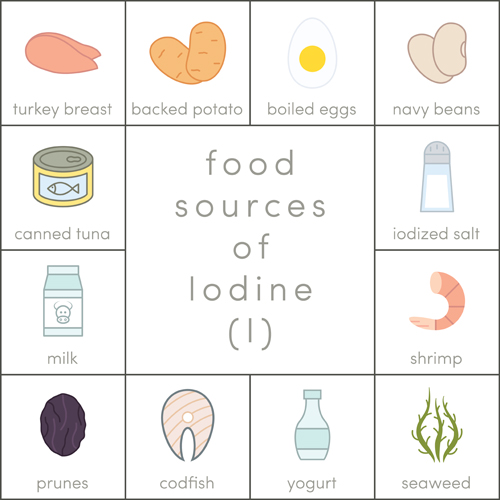
Women with moderate to severe iodine deficiency may take longer to achieve a pregnancy, compared to women with normal iodine levels, according to a study by researchers at the National Institutes of Health. The study is the first to investigate the potential effects of mild to moderate iodine deficiency—common among women in the United States and the United Kingdom—on the ability to become pregnant. It appears in the latest edition of Human Reproduction.
Iodine is a mineral used by the body to regulate metabolism. It also helps regulate bone growth and brain development in children. It is found in seafood, iodized salt, dairy products, and some fruits and vegetables. Severe iodine deficiency has long been known to cause intellectual and developmental delays in infants.
“Our findings suggest that women who are thinking of becoming pregnant may need more iodine,” said James L. Mills, M.D., who conducted the study along with colleagues at NIH’s Eunice Kennedy Shriver National Institute of Child Health and Human Development and the New York State Department of Health in Albany. “Iodine requirements increase during pregnancy, and the fetus depends on this mineral to make thyroid hormone and to ensure normal brain development.”
The researchers analyzed data collected from 501 U.S. couples who were planning pregnancy from 2005 to 2009. The couples were part of the Longitudinal Investigation of Fertility and the Environment (LIFE) study, which sought to examine the relationship between fertility, lifestyle and environmental exposures. When the women enrolled in the study, they provided a urine sample from which their iodine levels were measured. Each woman was also given a digital, at-home pregnancy test.
Of the 467 women analyzed for the current study, iodine status was sufficient in 260 (55.7 percent), mildly deficient in 102 (21.8 percent), moderately deficient in 97 (20.8 percent) and severely deficient in 8 (1.7 percent).
To estimate a couple’s chances of pregnancy during each menstrual cycle, the researchers used a statistical measure called the fecundability odds ratio (FOR). A FOR less than one suggests a longer time to pregnancy, while a FOR greater than one suggests a shorter time to pregnancy. The researchers found that women who had moderate-to-severe iodine deficiency had a 46-percent-lower chance of becoming pregnant during each menstrual cycle, compared to women who had sufficient iodine concentrations. Women in the mildly deficient range had a smaller, statistically insignificant increase in the time it took to conceive.
Although the study population was not a representative sample of the U.S. population, the authors note that the percentage of women in the study having insufficient iodine (44.3 percent) is close to that seen in population-wide studies. For example, a previous study estimated that 30 percent of U.S. women of childbearing age had insufficient levels of iodine. The authors concluded that if their findings are confirmed, public health officials in countries where iodine deficiency is common may want to consider programs to increase iodine intake in women of child-bearing age.
Women who are concerned they may not be getting enough iodine may wish to consult their physicians before making dietary changes or taking supplements.
###
About the Eunice Kennedy Shriver National Institute of Child Health and Human Development (NICHD): The NICHD sponsors research on development, before and after birth; maternal, child, and family health; reproductive biology and population issues; and medical rehabilitation. For more information, visit the Institute’s website at http://www.nichd.nih.gov/.
About the National Institutes of Health (NIH): NIH, the nation's medical research agency, includes 27 Institutes and Centers and is a component of the U.S. Department of Health and Human Services. NIH is the primary federal agency conducting and supporting basic, clinical, and translational medical research, and is investigating the causes, treatments, and cures for both common and rare diseases. For more information about NIH and its programs, visit http://www.nih.gov.

 BACK TO TOP
BACK TO TOP